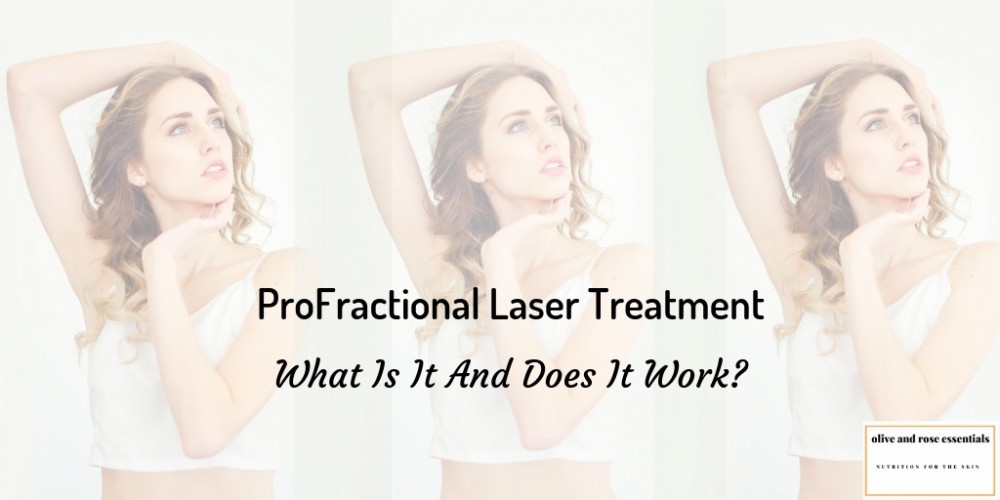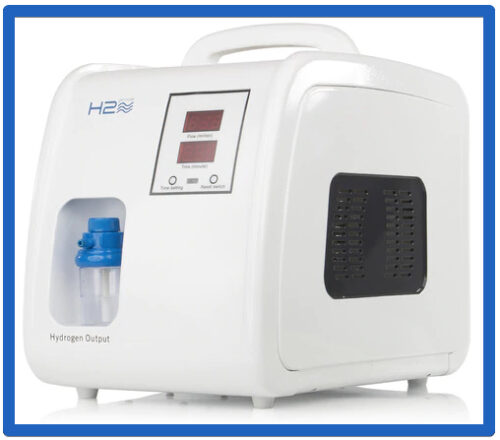ProFractional laser treatments are performed at skin care clinics or medical spas to stimulate the production of collagen, reduce scarring, and smooth discoloration, while improving the overall texture and appearance of the skin. Since the effects are cumulative, three or four treatments are suggested for optimal results. What is a ProFractional laser treatment and does it work?

Table of Contents
What Is ProFractional Laser?
ProFractional is an ablative fractional resurfacing procedure that punctures microscopic holes into the skin. This puncturing process prompts the body’s natural wound-healing response to produce collagen, which then fills the punctured channels. Because channels surrounding the ablated areas are left intact, less down time is required and healing is accelerated.
One incredible benefit of ProFractional is that collagen continues to be produced for up to a year following treatment. An extremely high-speed computerized scanner is used and settings adjusted according to depth of penetration, the area covered, the diameter of the puncture wound or spot size, and the coagulation level. Results range from subtle to dramatic depending on these parameters.
Coagulation And Heat
Lasers are used with or without coagulation, a measure of the amount of heat delivered into the tissues. Coagulation is especially helpful for reducing difficult-to-treat scar tissue, and for increased collagen remodeling. ProFractional is commonly preceded by a micro-laser peel to eliminate surface irregularities.
Coagulation stimulates a wound-healing response, of varying levels of heat-release. The more heat that is released, the better the results. Less heat is typically used for a first treatment. The sensation feels similar to a sunburn as heat is released into the skin.
Benefits Of A ProFractional Laser Treatment
- Stimulates collagen
- Improves texture
- Smooths and brightens complexion
- Reduces scarring
- Decreases age spots, freckles and skin discoloration
- Tightens and firms
- Decreases hooded eyelids
- Reduces lip lines and under eye wrinkles
- Tightens nasal labial folds
- Reduces pore size
- Repairs sun damage
- Treats melasma
Ablative Versus Non-Ablative Skin Resurfacing Laser Treatments
Ablate means to injure or remove, and that’s exactly what ablative lasers do – remove thin layers of skin. What do non-ablative lasers do then? Let’s find out. Ablative and non-ablative lasers differ in several ways:
Ablative Lasers
Ablative lasers are more aggressive, intense, and wounding as they go deeper into the dermis, removing and injury layers of the skin. This type of laser therapy requires more downtime for the skin to heal completely, but results are longer lasting. CO2 lasers are ablative as is ProFractional, a type of fractional erbium laser resurfacing, that uses the Sciton laser.
Fractional laser resurfacing does not treat the entire surface area, which allows for deeper penetration and a shorter recovery time. Treating 100% of the area requires more downtime and a longer healing period. Penetrating deep into the dermis stimulates collagen and elastin, proteins responsible for keeping the skin firm, smooth, and plump.
Thin layers of skin are vaporized to reveal fresh, younger-looking skin, while improving tone and texture. Ablative lasers target more serious skin conditions, such as scarring and skin lesions. Some clinics combine ablative and non-ablative laser treatments to yield even better results.
Non-Ablative Lasers
Non-ablative lasers don’t penetrate the skin as deeply as ablative lasers, injuring only the epidermis or outermost layer of the skin. The treatment is more superficial, is non-wounding, and requires less down time.
Non-ablative layers are good for sun damaged skin, age spots, and fine lines. Intense pulsed light (IPL) is an example of a non-ablative laser treatment. Lasers use heat to raise the cells’ temperature, without destroying them. Conversely, ablative lasers cause destruction of skin cells.
The results following a non-ablative laser treatment are more gradual and less dramatic than those using an ablative laser. Improvements in discoloration and skin texture will be more apparent than wrinkle reduction.
What To Expect
The degree of pain felt depends on the depth of the puncture holes. The deeper into the dermis the laser goes, the more painful the procedure. Superficial and more surface-based, non-ablative treatments are uncomfortable, but not too painful. Deep, aggressive treatments, however, are painful enough that numbing cream must be used an hour beforehand.
A regional nerve block may also be necessary. The more aggressive the treatment, the fewer sessions are needed, but the longer the downtime. A red, raw, puffy, sore, swollen face, bleeding from open wounds is normal. Applying ice to the area several times a day will quell inflammation and pain.
Laser settings are adjusted for each person receiving treatment, and will likely be different for subsequent treatments on the same person. Treatments last approximately 45 minutes. Certain medications and skin care products may need to be discontinued before treatment, such as blood thinners and tanning creams.
Following treatment, be sure and protect your skin from the sun as your face is basically an open wound. If you’re reading this article, you likely are already diligent when it comes to sun protection. Healing takes anywhere from three days to a week, and in some cases longer. Makeup can be applied after a few days depending on how intense the treatment was. Aquafor is a healing ointment and many people receiving ProFractional swear by it for relieving pain following treatment.
Is ProFractional Laser It Worth It?
Is ProFractional worth it will be partly dependent on your pocketbook as treatments are expensive. In fact, three sessions could put you back a minimum of $1800.00. I haven’t personally tried this type of laser treatment, but from what I’m reading, the reviews are mixed, with some people raving about their results and others disappointed.
The people that were less than thrilled with their results didn’t seem to think it was worth the money, and would rather focus on treatments they can do at home. If you’re thinking of doing a laser treatment, educate yourself, read reviews of people who have done a series of treatments, and consider the cost.
[Read More: How To Use A Dermaroller For Younger Looking Skin]
[Read More: The Benefits Of Glycolic Acid]
DIY Home Treatment
I like skin care treatments that can be done at home. Because of the convenience and affordability, it’s easier to be consistent, which will always equate to better results. Some of my favorite do-it-yourself techniques are:
Dermarolling
Red lamp therapy
Glycolic acid peels
Vitamin C serum with HA
 Key Points
Key Points
ProFractional laser treatment is an anti-aging procedure that ablates tiny channels in the skin, leaving areas in between unaffected, leading to better results and a shorter recovery time.
The wound-healing response stimulates collagen and elastin, giving the skin a firmer, plumper, smoother look. Treatments are expensive, quite painful, and a series are needed for optimal results.
Have you or someone you know had a ProFractional laser treatment? Let me know in the comments:)

Very interesting. I am curious if you could get similar anti-aging, collagen up-regulating effects through a combination of supplementing with a high quality collagen protein and using red light therapy, such as from the company JOOVV. Not that red light therapy is any cheaper than this, but perhaps less painful and similarly effective.
Interesting comparisons. Thank you for this article!
Thanks for reading Ben. I think supplementing with collagen is a great idea. Red light therapy is anti-aging and is remarkable for stimulating the production of collagen.
Joovv’s are amazing but expensive. You can buy red lights in the infrared spectrum at any hardware store, making therapy a lot more affordable. You can even make your own infrared sauna using these lights or use a single light for red lamp therapy.
You can shine the lamp on your face to decrease inflammation, clear up acne, and stimulate collagen. Or shine the light on a painful joint to reduce pain.
I personally have never done any of these treatments, after reading your review, I am not sure I would. I just do not understand the process as being beneficial. It sounds more like skin torture.
Is this more recommended for people with serious skin conditions?
I guess if I had a horrible skin condition, I could see where this could be helpful. But since I don’t, I will just continue on my routine of washing and moisturizing.
Stacie
Hi Stacie,
The process entails wounding the skin so the body’s natural healing response will stimulate collagen and elastin, the proteins responsible for keeping the skin youthful, plump, and elastic. From what I’m hearing, it hurts!!!
Non-ablative lasers are less painful but don’t penetrate into the dermis so the results are not as dramatic as with an ablative laser. ProFractional is the best of both worlds because it doesn’t treat the entire surface area, which allows for shorting recovery period, yet penetrates deeply for better results.
Thanks for reading!
Hi Dear,
I’ve never heard of this treatment before, but your post is very helpful.
I surely like the results one can get from it. But I don’t think it is something that I can do on a monthly basis. Maybe once a year, to help rejuvenate the body. Also because I can’t stand the pain.
I think it is something that I will definitely try.
Thanks for sharing!
Many people haven’t heard of a ProFractional laser treatment. You wouldn’t want to do it once a month, maybe every six months or yearly. And you’re right, it’s a painful treatment!
I appreciate your comment!
Hi Holly:
I’m a 66 year old man. My skin and hair are in relatively good shape for my age. Are Profactional Laser treatments effective on older skin like mine?
Boy, I’m telling you that I would really like to get rid of of my “age spots” and the overall uneveness of my skin tone.
I don’t mind a little pain if there are results so the ablative lasers sound appealing.
Tell me more about Vitamin C Serum with Hyaluronic Acid.
Thanks!
Hi Christopher,
ProFractional is good for older skin especially for blotchiness and age spots. It’s painful and expensive, but many people have gotten great results. You should check it out.
Vitamin C is an antioxidant so fights free radical damage on the skin and stimulates collagen. HA holds moisture in the skin, which we lose with age. Together, they’re amazing. You can buy my serum on my site.
Thanks for reading and taking the time to comment!
How does Profactional laser compare to UL Therapy? I am looking for a solution for toning and also wrinkles around the mouth.